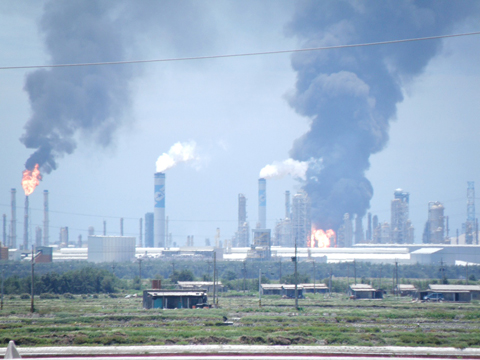Formosa Petrochemical Corp (台塑石化), the nation’s only listed oil refiner, said it had halted its No. 1 ethylene plant following a fire.
The blaze occurred at about 11:50am yesterday and is now under control, the company said in a statement delivered via mobile text-message. No one was injured, the Mailiao (麥寮), Yunlin County-based refiner said.
Formosa Petrochemical has three ethylene plants with a combined annual capacity of 2.935 million tonnes, including the No. 1 plant’s 700,000 tonnes. Ethylene is a raw material for plastics, chemicals and synthetic fibers. The company’s No. 2 ethylene plant has an annual capacity of 1.035 million tones, while the No. 3 plant offers 1.2 million tonnes.

PHOTO: CHEN TSAN-KUN, TAIPEI TIMES
Chemical supply to customers this month won’t be affected by the accident as the company draws on inventories, Formosa Petrochemical spokesman Lin Keh-yen (林克彥) said by telephone.
The impact on supply next month has yet to be determined, he said.
“We can’t evaluate how long the plant will be shut yet,” he said.
Asian naphtha prices fell yesterday on concern that demand from Taiwan would slow following the fire at Formosa plant. Open-specification naphtha dropped 1.7 percent to US$612.25 per tonne, according to data compiled by Bloomberg.

GROWING OWINGS: While Luxembourg and China swapped the top three spots, the US continued to be the largest exposure for Taiwan for the 41st consecutive quarter The US remained the largest debtor nation to Taiwan’s banking sector for the 41st consecutive quarter at the end of September, after local banks’ exposure to the US market rose more than 2 percent from three months earlier, the central bank said. Exposure to the US increased to US$198.896 billion, up US$4.026 billion, or 2.07 percent, from US$194.87 billion in the previous quarter, data released by the central bank showed on Friday. Of the increase, about US$1.4 billion came from banks’ investments in securitized products and interbank loans in the US, while another US$2.6 billion stemmed from trust assets, including mutual funds,

Micron Memory Taiwan Co (台灣美光), a subsidiary of US memorychip maker Micron Technology Inc, has been granted a NT$4.7 billion (US$149.5 million) subsidy under the Ministry of Economic Affairs A+ Corporate Innovation and R&D Enhancement program, the ministry said yesterday. The US memorychip maker’s program aims to back the development of high-performance and high-bandwidth memory chips with a total budget of NT$11.75 billion, the ministry said. Aside from the government funding, Micron is to inject the remaining investment of NT$7.06 billion as the company applied to participate the government’s Global Innovation Partnership Program to deepen technology cooperation, a ministry official told the

Taiwan Semiconductor Manufacturing Co (TSMC, 台積電), the world’s leading advanced chipmaker, officially began volume production of its 2-nanometer chips in the fourth quarter of this year, according to a recent update on the company’s Web site. The low-key announcement confirms that TSMC, the go-to chipmaker for artificial intelligence (AI) hardware providers Nvidia Corp and iPhone maker Apple Inc, met its original roadmap for the next-generation technology. Production is currently centered at Fab 22 in Kaohsiung, utilizing the company’s first-generation nanosheet transistor technology. The new architecture achieves “full-node strides in performance and power consumption,” TSMC said. The company described the 2nm process as

JOINT EFFORTS: MediaTek would partner with Denso to develop custom chips to support the car-part specialist company’s driver-assist systems in an expanding market MediaTek Inc (聯發科), the world’s largest mobile phone chip designer, yesterday said it is working closely with Japan’s Denso Corp to build a custom automotive system-on-chip (SoC) solution tailored for advanced driver-assistance systems and cockpit systems, adding another customer to its new application-specific IC (ASIC) business. This effort merges Denso’s automotive-grade safety expertise and deep vehicle integration with MediaTek’s technologies cultivated through the development of Media- Tek’s Dimensity AX, leveraging efficient, high-performance SoCs and artificial intelligence (AI) capabilities to offer a scalable, production-ready platform for next-generation driver assistance, the company said in a statement yesterday. “Through this collaboration, we are bringing two